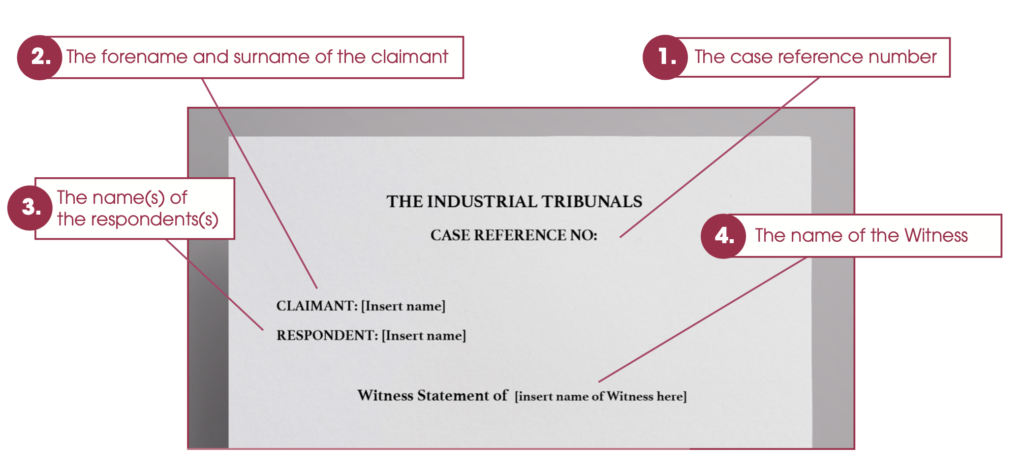Drafting Witness Statement
Drafting Your Own Witness Statement
Employment judges usually order parties to provide written witness statements (“Witness Statements”) in the following type of cases:
- Unfair Dismissal cases
- Discrmination cases
- Protected Disclosure claims
Focus and Limits of This Document
The focus of this document is on the drafting your own witness statement. However, that guidance may also be useful for anybody else, who is a witness on your behalf, when that other person is drafting his/her own Witness Statement.
It should not be assumed that this document contains a complete, and entirely accurate, or entirely up-to-date statement of all of the relevant legal principles and procedures.
The following information does not constitute legal advice; this document provides general
guidance only.
Layout Requirements
- Printed on A4 paper white paper.
- Typed, if possible. (If this is not possible, a clear and legible handwritten Witness Statement may be acceptable).
- Printed on one side of the page only.
- The Statement should be set out in paragraphs.
- The paragraphs should be numbered.
- If the Witness Statement is lengthy, it may be helpful to include headings (so as to make the Statement more readable).
Introduction
At the beginning of the Witness Statement, you should include the following information:
- The case reference number. (You can find this on any correspondents you
have recieved) - The forename and surname of the claimant.
- The name(s) of the respondent(s)
- The name of the Witness.

The Start of the Witness Statement
The first paragraph of the Witness Statement should include:
- Your name
- Your address
The following example shows how you should set out that information illustrated:
I, [insert your forename and surname], of [insert your address], say as follows:
The Purpose of your Witness Statment
The purpose of your Witness Statement is to set out in writing everything which you want to tell the tribunal.
The Witness Statement should set out your version of events, in respect of each of the main factual issues in the case, on which you are able to provide evidence. (For information about the list of main factual issues, see our CMPH guidance.)
The Witness Statement should set out what you saw, what you heard and/or what you thought was happening.
During the final hearing, you might only be allowed to rely on the facts contained in your Witness Statement. Therefore, if you want to bring a particular fact to the attention of the tribunal, you should include that fact in your Witness Statement. When writing a Witness Statement, you should mainly focus on statements of fact.
Your account of events should be set out in chronological order
When writing your Witness Statement, it is usually best to follow a chronological sequence of events. You should set out your account of events in date order. Start from the beginning.
It is best to specify the date/s of any event/s that is/are mentioned in your Witness Statement.
If you do not know the date of any particular event, or if you cannot remember
that date, you should give approximate date ranges.
TIP:
If you refer to someone in your Witness Statement, you should use their full name.
TIP:
If you refer to anyone in your Witness Statement, you should identify that individual both by their forename and by their surname. You should also explain their relevance to your account of events in your Witness Statement.

Personal knowledge, information or belief?
In relation to each factual statement which is contained in a Witness Statement, the Statement should indicate whether that statement is made:
- From your own knowledge
- The basis of information (provided to you by someone else)
- On the basis of belief
1.
In relation to any factual statement made on the basis of information, you should specify the source (of that information).
2.
In relation to any factual statement made on the basis of belief, you should specify the source (of that belief).
If you refer to any document in your Witness Statement, you should name that document; mention the full title of a policy document for example.
TIP:
Both Liability & Compensation Issues
Witness Statement should address factual issues relating to both of the following:
- Liability. (Why you should win)
- Amount. (How much compensation you should get)
The main compensation issues are as follows:
- The extent of any relevant financial loss
- Any efforts you made to reduce that loss
Proof of Finanical Loss
The following guidance applies only if both of the following two conditions apply to your situation:
- Your claim consists of, or includes an unfair dismissal claim or a discriminatory dismissal claim.
- You are claiming for financial loss arising out of that dismissal.
In that situation, your Witness Statement should contain details of the following:
What was your weekly net pay at the time of your dismissal?
1:
Have you been unemployed during any period after your dismissal? If so:
(1) Specify each period of unemployment.
(2) In relation to each period of unemployment,
specify:
– what type of social security benefits you
received and
– the weekly amount of any such benefits.
2:
Have you had any period or periods of employment, or any periods of employment,
since your dismissal? If so, in relation to each such period of employment, you should
specify the following:
(1) The name of your new employer
(2) The start date and the end date of that employment, (if any)
(3) Your net weekly pay during that employment
(4) What type of job where/are you doing during that employment?
3:
If you have only had one period of
employment since the date of your
dismissal, you only need to complete
the details specified in box 3 above in relation to that one period of employment.
4:
However, if you have had more
than one period of post-dismissal
employment, the information specified
in box 3 should be provided, separately,
in relation to each of those periods of
employment.
5:
Mitigation of Loss
The following guidance applies only if all of the following three conditions apply to your
situation:
- Your claim consists of, or includes a dismissal claim.
- You are claiming for financial loss arising out of that dismissal.
- Since that dismissal, you have been, or were, unemployed for a lengthllengthy period.
In that situation, your Witness Statement should contain details of the efforts which you made to find alternative employment.
What you should NOT include in a Witness Statement
- The Witness Statement should not include lengthy quotations from documents.
- The Witness Statement should focus on facts, not arguments:
(Witness Statements are for the giving of evidence, not for arguing why your claim should be successful). - You should avoid abbreviating words or phrases.
- You should avoid using jargon. If you have to use jargon, explain it briefly.
- The Witness Statement should not contain direct speech unless you genuinely do have word-for-word recollection of what was said. If you do remember the exact words, put them in quotation marks.
- When writing a Witness Statement, it may be necessary to set out the background. However, your account of the background facts should be relatively brief, so that those background facts do not distract the tribunal from focusing on the key disputed factual issues in the case.
- If you have had any discussions about the possibility of settling the case, the Witness
Statement should not refer to those discussions.
The end of the Witness Statement
At the end of the Witness Statement, you should include a statement of truth. Which should
look like the example below:
I believe that the facts stated in this Witness Statement are true:
Date:
Signed:
You should sign and date the Witness Statement.
During the Final Hearing, you will be asked to confirm, under oath, that all the statements in the Witness Statement are true. If you have made a false statement without an honest belief in its truth, you may be found guilty of perjury (which is a serious criminal offence).
Other Witnesses for the Claimant
If someone else is willing to give evidence on your behalf, that person (‘the Other Witness’) will probably also have to provide a written Witness Statement in advance of the hearing.
It would probably be best for the Other Witness to draft his/her own Witness Statement.
However, there is no reason why you cannot have a discussion with the Other Witness about the structure, layout and scope of that Statement.
The guidance in this document is designed to help you to draft your own Witness Statement. However, it will probably be useful to draw that guidanceto the attention of any Other Witness.